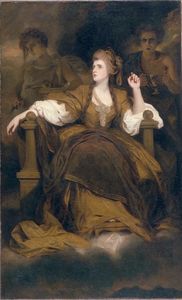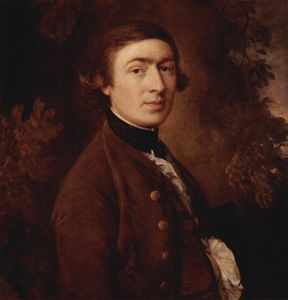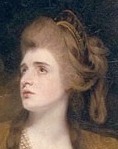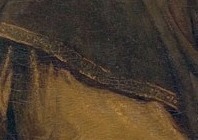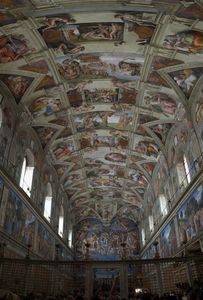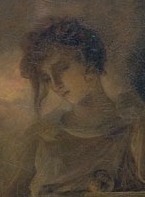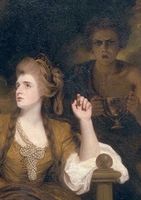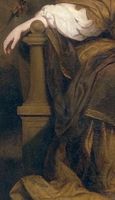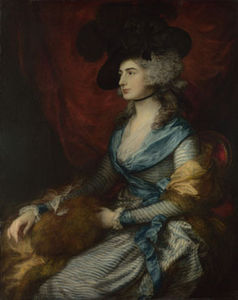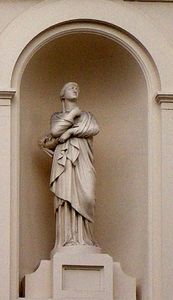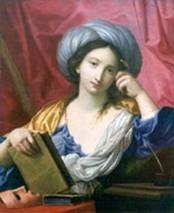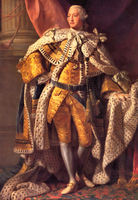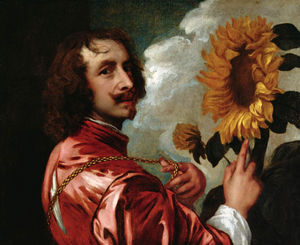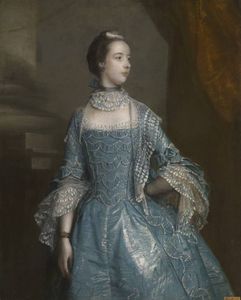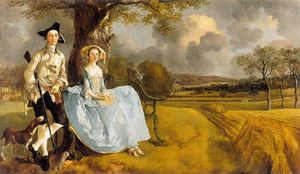Mrs. Siddons as the Tragic Muse
- Date of Creation:
- 1784
- Height (cm):
- 240.00
- Length (cm):
- 148.00
- Medium:
- Oil
- Support:
- Canvas
- Subject:
- Figure
- Art Movement:
- Rococo
- Created by:
- Current Location:
- San Marino, California
- Displayed at:
- Huntington Art Gallery
- Owner:
- Huntington Art Gallery
- Mrs. Siddons as the Tragic Muse Page's Content
- Story / Theme
- Inspirations for the Work
- Analysis
- Related Paintings
- Artist
- Art Period
- Bibliography
Mrs. Siddons as the Tragic Muse Story / Theme
Mrs. Sarah Siddons
"We may look at, as Britons, at Greek sculpture and Italian paintings, with a humble consciousness that our native art has never reached their perfection; but, in the drama, we can confront Aeschylus himself with Shakespeare"
-

Thomas Gainsborough
-

Mrs. Siddons as the Tragic Muse
-

Mrs. Siddons as the Tragic Muse
The story of Mrs. Siddons as The Tragic Muse is two-fold. There is the story of the real-life Mrs. Siddons who was a Shakespearean actress in the 18th century, and then there's the story of the Greek and Roman myth of Melpomene, the muse of tragedy. Both are explained below.
Mrs. Sarah Siddons:
Sarah Siddons was a well-known actress of the 18th century who became famous for her role as Shakespeare's Lady Macbeth. Born Sarah Kemble, aged 18 she married William Siddons, also an actor, and they had seven children of who only two survived.
Sarah's parents sent her to work as a lady's maid and with this job she was exposed to the works of England's literary greats such as Milton and Shakespeare. She also began acting and had a natural ability.
Eventually her marriage to William became strained and they separated from each other on their own terms.
Her acting career prospered and she was offered a position at Drury Lane where she became infamous for her role as the Queen of Tragedy and eventually was the leading actress at the theater. It has been said she funneled all of her sorrows from the death of her five children and her unhappy marriage into her acting and was invited to do private performances for the royal family.
Mrs. Siddons mixed with the well-to-do society of England throughout her life as well as knowing numerous playwrights and acting alongside the famous actor David Garrick, who was also frequently painted by Reynolds and Gainsborough.
Muse of Tragedy:
Melpoméne is a character from Greek and Roman mythology, one of nine muses of the arts. She was originally the Muse of Song but then became the Muse of Tragedy. Singing was often utilized in Greek tragedies, which is how the transition from Melpoméne's identification with song shifted to tragedy.
The name Melpoméne comes from the Greek word melpo or melpomai, which means "to celebrate with dance and song. " In many statues and paintings of Melpoméne, she is represented with a tragic mask and also often holds in her other hand a knife or club.
In Greek mythology, she is the daughter of Zeus and Mnemosyne, who had eight other daughters, Melpoméne's sisters and the eight other muses are: Calliope, muse of epic poetry; Clio, muse of history; Euterpe, muse of flute playing; Terpsichore, muse of dancing; Erato, muse of erotic poetry; Thalia muse of comedy; Polyhymnia, muse of hymns; and Urania, muse of astronomy.
Mrs. Siddons as the Tragic Muse Inspirations for the Work
Reynolds was inspired not only by Sarah Siddons' extreme talent to embody the tragic heroine in Macbeth, but also by the Classical subject matter of the muses from ancient Greek/Roman mythologies that numerous sculptors tried to create. Reynolds painted Siddons as Melpomene, the muse of tragedy.
This work was painted when Mrs. Siddons was 28 years old and in the prime of her career. When she entered Reynolds' studio he took her by the hand and said, "Ascend upon your undisputed throne, and graciously bestow upon me some great idea of the Tragic Muse".
Like the old masters, Reynolds signed his name secretly in the work by putting it on the gold embroidery at the hem of her dress. Some stipulate that Reynolds had used Mrs. Siddons as a public stint to gain attention after his last exhibition which was not as well received. But this is debatable.
Many scholars believe that Reynolds was inspired by Michelangelo's "Isaiah," (see Related Paintngs below) found on the ceiling of the Sistine Chapel, but Siddons maintained that the similarity in posture and body position were merely coincidental. Reynolds, she had said, had initially painted her in another position and she had shifted to a more favorable one.
Mrs. Siddons as the Tragic Muse Analysis
Composition:
Reynolds' technique for this composition relied heavily on his lighting effects and bold outlining that looked to reinforce natural harmony. The subject is in the full light and her presence is boldly outlined using this technique. The two allegories, Pity and Terror, stand behind her on two deeper planes.
Expression of Tragedy:
Reynolds painted Siddons' expression clearly in conflict yet with a very elegant and noble air that exuded a sense of grace. She looks undecided as the allegories cloud her judgment about her difficult situation which nevertheless will end in tragedy for the crime Lady Macbeth will commit, and the remorse she will suffer.
Reynolds knew that viewers of the piece would instantly identify it with Siddons' most famous acting role - Lady Macbeth.
Color Palette:
Reynolds uses elements of black and bright orange highlighting through the whole image to accentuate the sitter as the two figures, their facades painted in sweeping shadows, look to blend in with the brown, tempestuous background.
The flesh tone is achieved with various layering of whites over carmine and lake madder, with ultramarine and darker blue mixes Siddon's neck and skin in the shadow. Hints of grey are also present for the more prominent shadow areas.
Her dress is swathed in an array of delicately mixed yellow ochre, with dark and light browns. Various tints of orange can be seen showing through for the highlighted areas of the golden fabrics to create a natural sheen that reflects real life. Grays and stark white coats override the colors and image where shadow and light play.
Brush Work:
Siddons' head is very thinly painted with a delicate and fine brush while the coloring of her face is kept to a fine, thin layer. In fact, Reynolds feared that by over-glazing, he would ruin the final outcome.
The artist applies fine detail to the folds of the rich heavy fabric. The dress has looser, broader strokes as well as her shirt folds, which contain strong dashes of white strokes haphazardly applied around her arm with light brown and grey intermixed for the play of shadow in the folds to create depth. These strokes are both loose and light.
Soft, rounded strokes are used for the perilous clouds that gather around the actress' feet with rounded lines in red-orange for dramatic effect. The same bright orange can be seen in the drapery over her lap as well and in the allegorical figures.
These figures have smooth soft lines to make them look like actual sculptures in the fashion they were usually depicted in in the classical style.
Mrs. Siddons as the Tragic Muse Related Paintings
Mrs. Siddons as the Tragic Muse Artist
Mrs. Siddons as The Tragic Muse sold for 1,000 guineas at the time and received immense popularity. It was dubbed the "greatest female portrait in the world".
Sir Joshua Reynolds was the leading English painter of his time and almost exclusively painted portraits of the British gentry, often turning socialites into mythological characters within his works, much like in The Tragic Muse.
As a result of Reynolds's ability to prop the already high statures of his sitters up to other-worldly proportions, he is credited with creating the notion of celebrity.
His social circles became the same as those of whom he painted and the artist was eventually knighted and became the official court painter to George III. Not merely a painter, Reynolds also started a literature club and lectured about art, literature, philosophy, among other things.
The artist was well trained in the Classics from his time spent in his father's school in Plympton, Devon and he learned of the Italian masters under his mentor, Hudson. He was exposed to the works of van Dyck while he was studying in London.
However, his biggest inspiration came from his time spent in Italy where he noted all the great masters and learned about their compositional, chiaroscuro and coloring technicalities. Such knowledge impacted on his artistic career for the rest of his life.
Sir Joshua Reynolds completed over 3000 works of art, including a few preliminary sketches which were very rare as he wasn't a keen draughtsman. Reynolds' worked every hour he could, including Sundays, from morning to night. Even after his mild stroke and the deterioration of the sight in his left eye, he endeavored to discover new dimensions to the art of painting, his passion, until the end of his career and life. Thus he has been dubbed the father of British painting.
Mrs. Siddons as the Tragic Muse Art Period
Reynolds completed this painting during the Rococo era of the 18th century that lasted only about 90 years. Rococo took the opulent style of the Baroque era that preceded it and injected it will even more flamboyance.
The Rococo era originated from the French decorative style Racaille meaning 'decorative shell and rock work'. It primarily stemmed from the architecture and furniture style that was popular amongst the bourgeois and new rising wealthy class in France who wanted works that reinforced their wealth and pleasure in all their beauty and splendor.
The Rococo style soon caught on in England as the country had a huge rise in middle class and wealthy merchant businessmen due to its advances and control over new colonies in the West, South and East. Reynolds was able to serve the needs of this growing middle class with his flattering and elegant portraiture style.
The Rococo era was characterized by hedonistic freedom and a pursuit of all things aesthetically pleasurable. The Palace of Versailles was the ideal in decadent Rococo art and architecture with its ornate decoration and grandeur.
During the Rococo era portraiture was extremely across the world but particularly in Great Britain where pioneers of this style also include William Hogarth and Thomas Gainsborough.
Reynolds helped to define different concepts, not only in British painting, but across the Western world. He was a renowned intellectual who socialized in the elite social circles of London and received most recognition for his portraits, particularly of the London elite.
His popularity was due to his ability to raise the figureheads of the day to a mythological level, which flattered the subject.
Mrs. Siddons as the Tragic Muse Bibliography
For further information about Reynolds and his works please refer to the following list of recommended books.
• Farington, Joseph & Postle, Martin. Memoirs of Sir Joshua Reynolds. Pallas Athene, 2005
• McIntyre, Ian. Joshua Reynolds: The Life and Times of the First President of the Royal Academy. Allen Lane, 2003
• Reynolds, Joshua & Roberts, Keith. Joshua Reynolds. Bastei, 1968
• Reynolds, Joshua, Russell, Francis, Roberts, Keith & McIntyre, Ian. Joshua Reynolds. Purnell, 1966
• Reynolds, Joshua. Seven Discourses on Art. Kessinger Publishing, 2004
• Reynolds, Joshua & Wark, Robert R. Discourses on Art. Edition: illustrated, reprint. Huntington Library, 1959
• Wendorf, Richard. Sir Joshua Reynolds: The Painter in Society. Edition: illustrated. Harvard University Press, 1996

